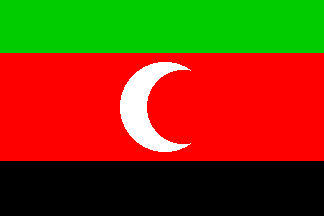 Image
reconstructed from written description by Ivan Sache, 22 Feb 2001
Image
reconstructed from written description by Ivan Sache, 22 Feb 2001
Last modified: 2015-05-24 by bruce berry
Keywords: sudan | arab | splm | anya-nya | lado | machar | secessionist |
Links: FOTW homepage |
search |
disclaimer and copyright |
write us |
mirrors
See also:
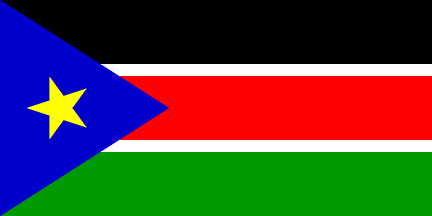 Image
by Željko Heimer, 03 Mar 1996
Image
by Željko Heimer, 03 Mar 1996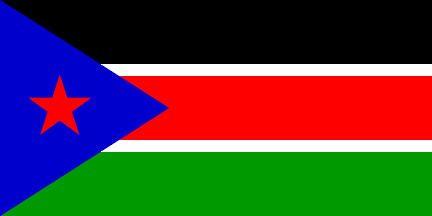 Image
by Jaume Ollé and Željko Heimer, 03 Mar 1996
Image
by Jaume Ollé and Željko Heimer, 03 Mar 1996This flag (with red star) is presumably that of the Sudan People's Liberation Movement
(or Front).
It appeared on television during a report related to the war in the south
of Sudan and was placed at the side of a personage who I think was Colonel
John Garang. The SPLM is not a separatist movement (like the Anya-Nya) but
operates in the South with the intention of taking power throughout the
country.
Jaume Ollé, 03 Mar 1996
On some web sites the flag (with the yellow star) is named the Christian flag of Sudan or the New Sudan flag.
Its colours are described as "black for the Africans,
red for those who died, green for the country and a star for the star of
Bethlehem." The description of the yellow star as "star of Bethlehem" was found on
other (non-Christian) websites, too. If this meaning of the star
is "official" or just an individual interpretation it is not clear. The movement name is nowadays used on
web-site of Free Sudan Center
the Sudan Liberation Movement and its military wing, the Sudan Liberation Army (SLM/SLA), based mainly in the
southern province of Dafur.
various reports, May 2004
We have many southern Sudanese people here (Rochester, Minnesota, USA) who call their flag New Sudan.
It has 5 stripes like Kenya, black/white/red/white/green.
The blue triangle is blue and the star is yellow, not red, and pointing to the pole, away from the point of the triangle.
Lee L. Herold, 14 Sept1999
I believe that the first star was red and later (early 1990's) changed to yellow. I saw this flag with red star at side of Garang with red star, but many years ago.
Jaume Ollé, 17 Oct 1999
Sudan can be divided in two major ethnic-religious parts: in the North the
Arab-Muslim population with the capital of Khartoum, in the South the black
African Christian and animistic population. The Civil war broke out because
of the South's resistance against the Northern government, the National
Islamic Front (NIF), which wanted to impose the Islamic law on the whole
country.
At http://en.wikipedia.org/wiki/History_of_Sudan#Civil_strife there is a
good summary of this conflict, and you find also information about the new
conflict in the Darfur region.
A quotation from that site:
"Peace talks between the southern rebels and the government made substantial
progress in 2003 and early 2004, although skirmishes in parts of the south
have reportedly continued. The two sides have agreed that, following a final
peace treaty, southern Sudan will enjoy autonomy for six years, and after
the expiration of that period, the people of southern Sudan will be able to
vote in a referendum on independence. Furthermore, oil revenues will be
divided equally between the government and rebels during the six-year
interim period. The ability or willingness of the government to fulfull
these promises has been questioned by some observers, however, and the
status of three central and eastern provinces remains a point of contention
in the negotiations."
The liberation movements in South Sudan don't have the same aims concerning the status of autonomy. e.g. the SSLM ( http://members.tripod.com/SudanInfonet/SSLM_Declaration.htm ) pursues full independency whereas http://www.southsudannation.com/ reports voices that still hope for a democratic *and* united Sudan. It is also mentioned there a SPLA/M manifesto from 1983 in which the unity of the country is maintained as a goal but for today there is reported a vast majority in the SPLA/M who aims for independence. However there seems to be still a certain partition about this question within the SPLA/M, for the AFP news agency reports a pro-Sudan manifestation in Khartoum, organized by the African National Union, an association close to the SPLA/M. There was also displayed the "Rebel flag" for the first time in Khartoum, see http://www.sudan.net/news/posted/8569.html
So this "Rebel flag" or "New Sudan Flag" is used now by all parties in the South, be they for independence or just an autonomous status within Sudan. I think if South Sudan should become independent, this flag has good chances to become its national flag.
We can see that the "New Sudan Flag" is derived from the old SPLA/M flag; just the colour of the star changed from red to yellow. In an off-list message Jaume Ollé gave me background information which could shed light on that change. He wrote that after the fall of the Soviet-Union the leadership of the originally pro-communist movement widened its political spectrum and looked for American help. The change of the colour of the red star could be a consequence of this new orientation. Jaume reported also to have found in the web a photo of the red star flag which had been digitally changed to a yellow star flag. It seems that the yellow-star flag is not a new variant *beside* the old flag, but should replace it. This would mean a major propaganda success for the SPLA/M which could impose its party flag on the whole South Sudan. The SPLM (Sudanese People's Liberation Movement) is the civil arm of the SPLA (Sudanese People's Liberation Army).
There are some notions subsumed as "various reports" which seem a bit
strange to me. It's said that on some websites the "New Sudan Flag" is
called "The Christian flag of Sudan". This is new to me and I'd like to know
the source for this remark. I hope it's not derived from my message in which
I attached photos showing Sudanese Christians waving the Christian Flag
together with the "New Sudan Flag"? The description of the yellow star as
"Star of Bethlehem" doesn't make this flag a "Christian flag", all the more
the Star-of-Bethlehem story is perhaps an individual interpretation.
Another thing: the formulation "The movement name is nowdays ... the Sudan
Liberation Movement and its military wing, the Sudan Liberation Army
(SLM/SLA), based mainly in the southern province of Dafur" is misleading
because it suggests that SLM/A is just a new name for SPLM/A. In fact these
are two different organizations. The SLM/A was founded in the Darfur region
when the conflict broke out there in 2003. The SPLM/A still exists as
liberation movement for the South. And Darfur shouldn't be described as
"Southern province" but as Western or South-Western province lest it isn't
confounded with the whole South Sudan. You can find links to both
organizantions at http://mathaba.net/sudan/index1.htm.
Martin Karner18 July 2004
[South Sudan became an independent country on 09 July 2011 - Ed]
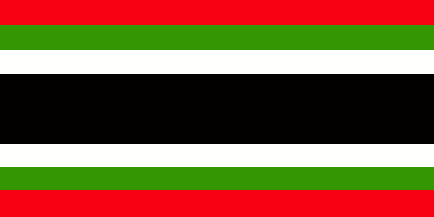 Image
by Jaume Ollé, 03 Mar 1996
Image
by Jaume Ollé, 03 Mar 1996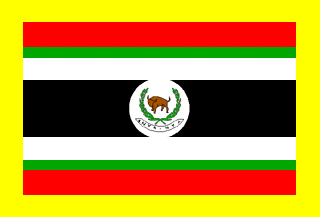 Image
by Jaume Ollé, 03 Mar 1996
Image
by Jaume Ollé, 03 Mar 1996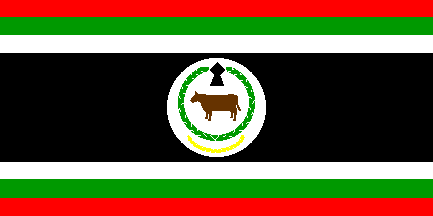 Image
by Ivan Sache, 12 Sept 1999
Image
by Ivan Sache, 12 Sept 1999
From the Aspirant Peoples flag chart:
22. "Anya-Nya (Separatist movement, 1970's) - South Sudan."
Horizontal red-green-white-black-white-green-red, the black stripe being as high
as all the other together.
The Encyclopaedia Universalis says: "The Anya-Nya guerilla began against the military regime of general Ibrahim Abboud (1958-1964) in the southern provinces of Bahr-el-Ghazal, Upper Nile and Equatoria. During the second military
dictatorship of General Jaafar-al-Nimeyri (1969-1985), Joseph Lagu, former leader of the
guerilla and member of the minority tribe Mandeli, was elected deputy in 1982."
Ivan Sache, 12 September 1999
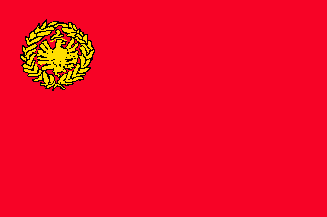 Image
by Jaume Ollé, 19 Nov 1996
Image
by Jaume Ollé, 19 Nov 1996General Riak Machar give his name to a movement that was formed in August 1991 as
a break-away from the Sudan People's Liberation Army.
Jaume Ollé, 19 Nov 1996
Background on the group: Southern Sudan Independence Movement (SSIM).
Aliases: Movement of Riak Machar, Southern Sudan Independence Army,
Southern Sudan Independence Movement/Army (SSIM/A), Sudan People's
Liberation Army United (SPLA United).
Founding Philosophy: The Southern Sudan Independence Movement (SSIM)
was a militant rebel army in southern Sudan opposed to the Khartoum
government, which is perceived to favor the minority northern Arab
Muslim population over the southern Sudanese animist/Christian people.
SSIM fighters were mainly of Nuer descent and came from the oil-rich
region of the Upper Nile. This organization focused on conducting
combat operations against the Sudanese military, though at times it
resorted to terrorist tactics against non-combatant targets, as seen
in its 1995 kidnapping of 12 Medicins Sans Frontieres (MSF) workers.
Originally called the SPLM/A-United, the SSIM was created by Dr. Riak
Machar in August 1991 when it split from John Garang's mainly
ethnic-Dinka Sudan People's Liberation Army (SPLA) over philosophical
differences. As their names would suggest, the SPLA envisioned a
unified and democratic Sudan as their goal, whereas the SSIM faction
was willing to secede from Sudan if the government would not meet
their demands for equal treatment. Ironically, it was the SSIM that
would merge with government forces in April 1996, when Khartoum and
six rebel groups from the south, including the SSIM, signed a peace
agreement. In April 1997, the agreement was formalized in the Sudan
Peace Agreement, which created the United Democratic Salvation Front
(UDSF), a political body that served to merge elements of the militant
groups into the government and internal security forces of the state.
The military wing of this body, used to patrol Southern Sudan on
behalf of the government, was called the Southern Sudan Defense Forces
(SSDF) and was led by Machar. In August 1997, the Khartoum government
appointed Machar to the Presidency of the Coordinating Council of the
Southern States and Assistant of the President of the Republic, a
cabinet-level position.
Current Goals: The SSIM never recovered from Machar's decision to
integrate into the government, and for all intents and purposes,
became inactive after it merged into the SSDF, though some ex-SSIM
fighters have since merged into both anti- and pro-government forces
in Southern Sudan.
Source: http://www.tkb.org/Group.jsp?groupID=4274
Further information at: http://en.wikipedia.org/wiki/Riek_Machar
Esteban Rivera, 09 Mar 2006
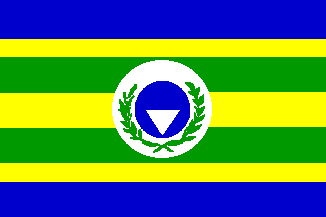 Image
by Jaume Ollé, 19 Nov 1996
Image
by Jaume Ollé, 19 Nov 1996The Lado territory was a British possession which the British
government rented to the Congo Free State in 1894. It was returned
to Sudan in 1910. The Bari people in Lado have demanded
independence for the territory and have adopted this flag.
Jaume Ollé, 19 Nov 1996
My 'Allers Illustrerede Konversations-Leksikon' from 1906-10 (third volume, K-Me: 1908) says about Lado:
"Trade station in Eastern Sudan [This is 'Sudan' in the old
meaning. Today, 'Sahel' would be used instead] on the White Nile [Bahr-el-Djebel]. Built 1874 by the well-known Gordon Pasha, and was the most important station in Egyptian Sudan; after the
Mahdi's revolt, it was completely cut off from
Egypt 1885; now, leased from England, a part of the
Congo State."
Ole Andersen, 12 Aug 2000
There's more:
1909 - Lado enclave ceded by Belgium from Congo to the Sudan
1912 - Southern half of Lado enclave ceded from the Sudan to Uganda as
W. Nile province: Bari-Lotuka area ceded to the Sudan
Source: Freeman-Grenville, 'Chronology of African History', 1973
Lado Enclave: A territory on the West bank of the Nile river north of
Lake Albert, now in Uganda and in south east
Sudan; 15.000 square miles;
explored by British 1870 and later, and claimed for Great Britain 1894;
leased to Belgium 1894-1910. Chief town was Lado, on the Nile just south
of Mongalla, Sudan.
Source: Webster's New geographical Dictionary, 1988
Jarig Bakker, 12 Aug 2000
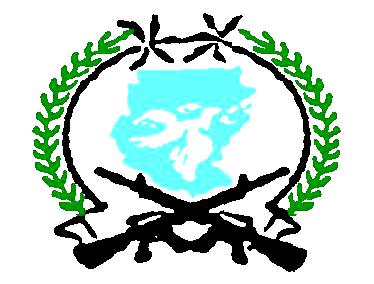 Image
by Steve Stringfellow, 06 May 1998
Image
by Steve Stringfellow, 06 May 1998A referendum in the south of Sudan, once the borders are established, could spell a new flag of a new nation.
Steve Stringfellow, 06 May 1998
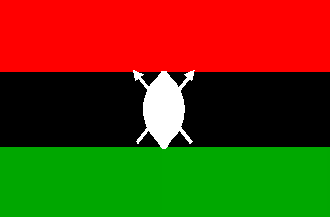 Image
by Jaume Ollé, 05 Sep 1998
Image
by Jaume Ollé, 05 Sep 1998
The Nile State (provinces of Bahr el Ghazal, Equatoria and Upper Nile) self
proclaimed state in Southern Sudan used (communication from Francois Chaurel,
in "Le Figaro", 25-6-69, and Karl Fachinger 26-8-71) a flag of red, black, green
with with a device in center. But recently I received a
photo in color from François Burgos, that show this flag but the lower
stripe is clearly light blue instead green.
Jaume Ollé, 05 Sept 1998
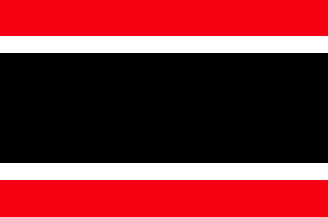 Image
by Jaume Ollé, 03 Mar 1996
Image
by Jaume Ollé, 03 Mar 1996Azania was also a word used by leftist groups during the apartheid regime in
South
Africa as "local" name of new South Africa to be, however it seems to have been
derived from Arab "al-zandjijja", meaning the land from the blacks.
Franc van Diest, 13 Jan 2000
There was some debate prior to 1994 as to whether the name of South Africa
should be changed to Azania. However, the term is not originally from South
Africa and actually refers to a part of East Africa in Tanzania.
Bruce Berry, 13 Jan 2000
For several centuries until the 11th century, Azania was used by Arab
seafarers for that part of Eastern Africa, with which they traded. Azania
refers to 'the land of the blacks' - compare with the Arab word for a black
person 'zanj'.
Ole Andersen, 13 Jan 2000
In South Sudan and Northeast Congo there was
(is) a tribe named 'Azande(h)' - which had nothing to do (as far as I know) with
Azania / Zanj / Zanzibar. So instead of: 'Azanian' read (possibly): 'Azande Liberation Front'?
Jarig Bakker, 13 Jan 2000
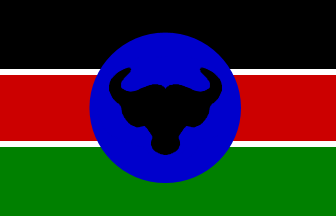 Image
by Eugene Ipavec, 08 Mar 2006
Image
by Eugene Ipavec, 08 Mar 2006Source: South Sudan Liberation Movement (SSLM)
website
located by Mikhail Revnivtsev, 07 Mar2006.
sslm.gif) Image
by Eugene Ipavec, 08 Mar 2006
Image
by Eugene Ipavec, 08 Mar 2006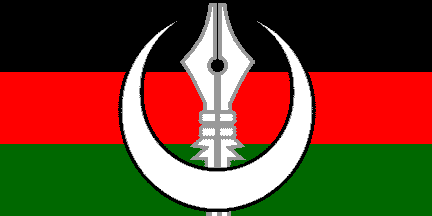 Image
by Victor Lomantsov, 10 Mar 1996
Image
by Victor Lomantsov, 10 Mar 1996
From the Umma website:
The Sudanese Patriots who established Umma Party in February 1945 as the fist Popular Political Party, aimed at attaining the country’s independence from the Condominium Reign. The Umma Party is the Party of Sudanese Independence. It championed that cause until it became the basis for Sudanese consensus in 1955. (The country's Independence was announced in 1st Jan 1956). It bore the brunt of opposition to all the Dictatorial Regimes, which came to power through coup d’etat. It drew the largest electoral votes in all the free General elections, which took place in the Sudan. It masterminded all the initiatives to arrive at a Great Compromise between North and South. It initiated the principle of making citizenship the basis for Constitutional Rights, the recognition of Religious and Cultural plurality in the Sudan, and a program to resolve the issues of Religion and Politics, Religion and State, on a basis which reconciles National unity and Religious loyalties. Currently the Umma Party is championing the cause of a negotiated Just Peace, and Democratic Transformation and so putting an end to the War and to Totalitarianism.
Elected (April 2003) President of Umma Party is Imam Al Sadig Al Mahdi.
See also: Flags of the Mahdi.
Victor Lomantsov, 10 Mar 1996
 Image
reconstructed from written description by Ivan Sache, 22 Feb 2001
Image
reconstructed from written description by Ivan Sache, 22 Feb 2001
Darfur is the westernmost part of Sudan, along the
Chadian border.
The major ethnic group is the Fur. According to "Nations Without
States" the flag of the Fur national movement is a 1:2:1 horizontal
tricolor of green, red and black, with a white crescent on the center
stripe.
Ned Smith, 21 Feb 2001
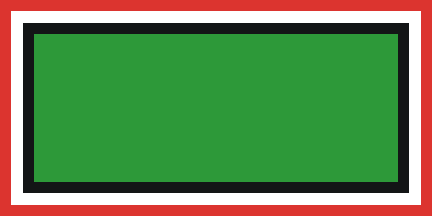 Image by
Martin Grieve, 08 Dec 2007
Image by
Martin Grieve, 08 Dec 2007
Last week on the Sky News there was a report about British
School teacher Gillian Gibbons' incarceration over the
debacle of naming a teddy bear Mohammed. During some television footage of protesters in Khartoum
(presumably outside of the Police station where Gibbons was being held) at least two flags of the same design were noticed being waved.
These were green with a red-white-black border around the edges and therefore in the same colours of Sudan's National flag.
Martin Grieve, 08 Dec 2007
Though the event at which it was flown was
described as a rally of an unnamed "Islamic citizen's association"
that had bussed members into Khartoum to protest the outrage;
it could be their flag.
Eugene Ipavec, 09 Dec 2007